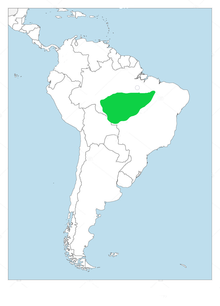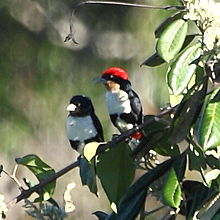292:
33:
102:
77:
403:
223:
58:
312:
The black-girdled barbet is approximately 18 cm (7.1 in) long and weighs 56 to 74 g (2.0 to 2.6 oz). The adult male's entire crown and nape are scarlet, the sides of the head black, and the chin and throat various shades of brown. Its back is black. Its underparts are white or
313:
off-white on the upper breast merging to pale greenish yellow on the belly. Its flanks are black, which extends nearly across the lower breast forming the "girdle". The adult female differs in that its crown and nape are black. The immature is similar to the adult but duller overall.
382:
Specimens of the black-girdled barbet indicate that it primarily breeds between August and
November, though February and June are also implicated. It is assumed to nest in a tree cavity like other New World barbets, but its nest and eggs have not been described.
508:
Remsen, J. V., Jr., J. I. Areta, E. Bonaccorso, S. Claramunt, A. Jaramillo, D. F. Lane, J. F. Pacheco, M. B. Robbins, F. G. Stiles, and K. J. Zimmer. Version 23 May 2021. A classification of the bird species of South
America. American Ornithological Society.
420:
has assessed the black-girdled barbet as
Vulnerable since 2012; previously it had been classed as being of Least Concern. The combination of the species' dependence on mature forest and the continued deforestation in Amazonia led to the reassessment.
265:
Since its description in 1916, the black-girdled barbet has almost always been recognized as a species. However, it was briefly considered to be a subspecies of black-spotted barbet (
703:
822:
742:
842:
677:
716:
832:
837:
342:
721:
628:
326:
291:
747:
539:), version 1.0. In Birds of the World (T. S. Schulenberg, Editor). Cornell Lab of Ornithology, Ithaca, NY, USA.
32:
755:
101:
760:
615:
555:
633:
196:
465:
607:
212:
66:
370:
Little is known about the black-girdled barbet's diet other than that it includes both fruit and
96:
708:
781:
734:
651:
593:
786:
460:
354:
350:
163:
620:
827:
768:
81:
442:
510:
288:
honors Lee Garnet Day, one of the leaders of the expedition that discovered the bird.
816:
729:
451:
296:
86:
41:
270:
656:
643:
690:
587:
338:
334:
300:
246:
45:
578:
222:
794:
153:
799:
391:
The black-girdled barbet's song is "a steadily accelerating series of hollow
371:
281:
113:
773:
572:
540:
322:
133:
345:
Department of northeastern
Bolivia. It inhabits the canopy of evergreen
57:
682:
602:
330:
254:
695:
346:
250:
173:
123:
49:
669:
549:
406:
396:
664:
488:
290:
417:
242:
143:
553:
487:
Gill, F.; Donsker, D.; Rasmussen, P. (January 2021).
562:
511:
https://www.museum.lsu.edu/~Remsen/SACCBaseline.htm
535:Schulenberg, T. S. (2020). Black-girdled Barbet (
466:10.2305/IUCN.UK.2016-3.RLTS.T22681917A92925988.en
398:. It has at least two calls, a series of notes "
374:. Its foraging behavior has not been described.
321:The black-girdled barbet is found in southern
8:
550:
531:
529:
527:
525:
523:
521:
519:
221:
75:
56:
31:
22:
464:
269:). DNA data have shown it instead to be
249:, the New World barbets. It is found in
430:
541:https://doi.org/10.2173/bow.blgbar1.01
436:
434:
325:. In Brazil it occurs in southeastern
823:IUCN Red List near threatened species
7:
452:IUCN Red List of Threatened Species
843:Taxa named by George Kruck Cherrie
341:. Its range extends slightly into
14:
405:and "a peculiar grating rattle"
100:
441:BirdLife International (2016).
489:"IOC World Bird List (v 11.1)"
1:
833:Birds of the Brazilian Amazon
280:The black-girdled barbet is
333:, the northwestern half of
859:
353:and also adjacent mature
220:
202:
195:
97:Scientific classification
95:
73:
64:
55:
39:
30:
25:
459:: e.T22681917A92925988.
317:Distribution and habitat
273:to five-colored barbet (
261:Taxonomy and systematics
838:Birds described in 1916
284:. Its specific epithet
304:
543:retrieved 25 May 2021
513:retrieved 24 May 2021
294:
26:Black-girdled barbet
233:black-girdled barbet
329:, most of southern
67:Conservation status
305:
241:) is a species of
810:
809:
782:Open Tree of Life
556:Taxon identifiers
229:
228:
90:
850:
803:
802:
790:
789:
777:
776:
764:
763:
751:
750:
738:
737:
725:
724:
712:
711:
699:
698:
686:
685:
673:
672:
660:
659:
647:
646:
637:
636:
624:
623:
611:
610:
608:26159E526538915F
598:
597:
596:
583:
582:
581:
551:
544:
533:
514:
506:
500:
499:
497:
495:
484:
478:
477:
475:
473:
468:
438:
355:secondary forest
225:
208:
105:
104:
84:
79:
78:
60:
35:
23:
858:
857:
853:
852:
851:
849:
848:
847:
813:
812:
811:
806:
798:
793:
785:
780:
772:
769:Observation.org
767:
759:
754:
746:
741:
733:
728:
720:
715:
707:
702:
694:
689:
681:
676:
668:
663:
655:
650:
642:
640:
632:
627:
619:
614:
606:
601:
592:
591:
586:
577:
576:
571:
558:
548:
547:
534:
517:
507:
503:
493:
491:
486:
485:
481:
471:
469:
440:
439:
432:
427:
414:
400:rok rok ock ock
389:
380:
368:
363:
319:
310:
263:
216:
210:
204:
191:
99:
91:
82:Near Threatened
80:
76:
69:
17:
16:Species of bird
12:
11:
5:
856:
854:
846:
845:
840:
835:
830:
825:
815:
814:
808:
807:
805:
804:
791:
778:
765:
752:
739:
726:
713:
700:
687:
674:
661:
648:
638:
625:
612:
599:
584:
568:
566:
560:
559:
554:
546:
545:
515:
501:
479:
429:
428:
426:
423:
413:
410:
388:
385:
379:
376:
367:
364:
362:
359:
351:várzea forests
337:, and eastern
318:
315:
309:
306:
275:C. quinticolor
262:
259:
245:in the family
227:
226:
218:
217:
211:
200:
199:
193:
192:
185:
183:
179:
178:
171:
167:
166:
161:
157:
156:
151:
147:
146:
141:
137:
136:
131:
127:
126:
121:
117:
116:
111:
107:
106:
93:
92:
74:
71:
70:
65:
62:
61:
53:
52:
37:
36:
28:
27:
15:
13:
10:
9:
6:
4:
3:
2:
855:
844:
841:
839:
836:
834:
831:
829:
826:
824:
821:
820:
818:
801:
796:
792:
788:
783:
779:
775:
770:
766:
762:
757:
753:
749:
744:
740:
736:
731:
727:
723:
718:
714:
710:
705:
701:
697:
692:
688:
684:
679:
675:
671:
666:
662:
658:
653:
649:
645:
639:
635:
630:
626:
622:
617:
613:
609:
604:
600:
595:
589:
585:
580:
574:
570:
569:
567:
565:
561:
557:
552:
542:
538:
532:
530:
528:
526:
524:
522:
520:
516:
512:
505:
502:
490:
483:
480:
467:
462:
458:
454:
453:
448:
446:
437:
435:
431:
424:
422:
419:
411:
409:
407:
404:
401:
397:
394:
386:
384:
377:
375:
373:
365:
360:
358:
356:
352:
348:
344:
340:
336:
332:
328:
324:
316:
314:
307:
303:state, Brazil
302:
298:
297:Alta Floresta
293:
289:
287:
283:
278:
276:
272:
268:
260:
258:
256:
252:
248:
244:
240:
239:
234:
224:
219:
214:
209:
207:
201:
198:
197:Binomial name
194:
190:
189:
184:
181:
180:
177:
176:
172:
169:
168:
165:
162:
159:
158:
155:
152:
149:
148:
145:
142:
139:
138:
135:
132:
129:
128:
125:
122:
119:
118:
115:
112:
109:
108:
103:
98:
94:
88:
83:
72:
68:
63:
59:
54:
51:
47:
43:
42:Alta Floresta
38:
34:
29:
24:
21:
19:
563:
536:
504:
492:. Retrieved
482:
472:14 September
470:. Retrieved
456:
450:
444:
415:
399:
392:
390:
387:Vocalization
381:
369:
320:
311:
285:
279:
274:
267:Capito niger
266:
264:
237:
236:
232:
230:
205:
203:
188:C. dayi
187:
186:
174:
20:
18:
800:Capito-dayi
756:Neotropical
691:iNaturalist
594:Capito dayi
588:Wikispecies
564:Capito dayi
537:Capito dayi
445:Capito dayi
347:terra firme
335:Mato Grosso
308:Description
301:Mato Grosso
247:Capitonidae
238:Capito dayi
206:Capito dayi
164:Capitonidae
46:Mato Grosso
817:Categories
795:Xeno-canto
494:14 January
425:References
372:arthropods
343:Santa Cruz
295:A pair at
154:Piciformes
40:A male at
282:monotypic
182:Species:
120:Kingdom:
114:Eukaryota
735:22681917
709:10596314
621:22681917
616:BirdLife
579:Q1264685
573:Wikidata
378:Breeding
361:Behavior
339:Rondônia
327:Amazonas
323:Amazonia
160:Family:
134:Chordata
130:Phylum:
124:Animalia
110:Domain:
87:IUCN 3.1
761:blgbar1
683:2479045
670:blgbar1
644:blgbar1
603:Avibase
395:notes"
366:Feeding
255:Bolivia
213:Cherrie
170:Genus:
150:Order:
140:Class:
85: (
48:state,
828:Capito
787:815708
722:554250
696:116850
634:111302
412:Status
271:sister
251:Brazil
215:, 1916
175:Capito
50:Brazil
774:70832
748:91765
704:IRMNG
665:eBird
641:BOW:
743:NCBI
730:IUCN
717:ITIS
678:GBIF
657:QQFK
629:BOLD
496:2021
474:2023
457:2016
418:IUCN
416:The
349:and
331:Pará
286:dayi
253:and
243:bird
231:The
144:Aves
652:CoL
461:doi
393:boo
277:).
819::
797::
784::
771::
758::
745::
732::
719::
706::
693::
680::
667::
654::
631::
618::
605::
590::
575::
518:^
455:.
449:.
433:^
408:.
402:"
357:.
299:,
257:.
44:,
498:.
476:.
463::
447:"
443:"
235:(
89:)
Text is available under the Creative Commons Attribution-ShareAlike License. Additional terms may apply.



